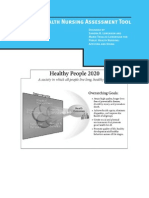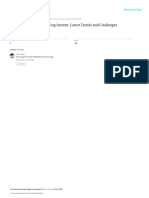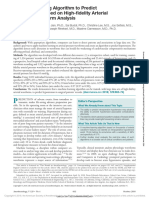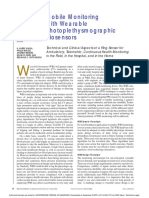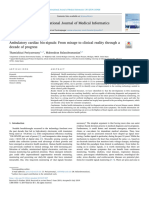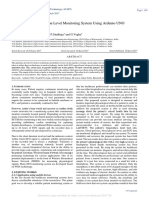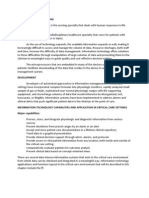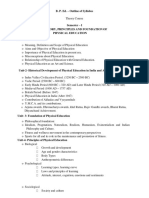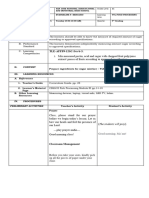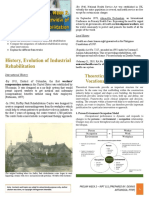0 ratings0% found this document useful (0 votes)
33 viewsNursing Informatics Midterm
Nursing Informatics Midterm
Uploaded by
Rhizel Marie Cauilan FariñasThis document provides an overview of various applications of nursing informatics including computer generated nursing care plans, critical pathways, clinical guidelines, and e-journals. It then discusses several technologies used in hospital and critical care settings such as physiological monitoring systems, hemodynamic monitors, thermodilution technique, pulse oximetry, telemetry, and arrhythmia monitors. Specific technologies are described in more detail including hemodynamic monitors, pulse oximetry, and telemetry. The document also discusses critical care information systems, clinical information systems, and vital sign monitoring.
Copyright:
© All Rights Reserved
Available Formats
Download as DOCX, PDF, TXT or read online from Scribd
Nursing Informatics Midterm
Nursing Informatics Midterm
Uploaded by
Rhizel Marie Cauilan Fariñas0 ratings0% found this document useful (0 votes)
33 views7 pagesThis document provides an overview of various applications of nursing informatics including computer generated nursing care plans, critical pathways, clinical guidelines, and e-journals. It then discusses several technologies used in hospital and critical care settings such as physiological monitoring systems, hemodynamic monitors, thermodilution technique, pulse oximetry, telemetry, and arrhythmia monitors. Specific technologies are described in more detail including hemodynamic monitors, pulse oximetry, and telemetry. The document also discusses critical care information systems, clinical information systems, and vital sign monitoring.
Original Title
NURSING INFORMATICS MIDTERM
Copyright
© © All Rights Reserved
Available Formats
DOCX, PDF, TXT or read online from Scribd
Share this document
Did you find this document useful?
Is this content inappropriate?
This document provides an overview of various applications of nursing informatics including computer generated nursing care plans, critical pathways, clinical guidelines, and e-journals. It then discusses several technologies used in hospital and critical care settings such as physiological monitoring systems, hemodynamic monitors, thermodilution technique, pulse oximetry, telemetry, and arrhythmia monitors. Specific technologies are described in more detail including hemodynamic monitors, pulse oximetry, and telemetry. The document also discusses critical care information systems, clinical information systems, and vital sign monitoring.
Copyright:
© All Rights Reserved
Available Formats
Download as DOCX, PDF, TXT or read online from Scribd
Download as docx, pdf, or txt
0 ratings0% found this document useful (0 votes)
33 views7 pagesNursing Informatics Midterm
Nursing Informatics Midterm
Uploaded by
Rhizel Marie Cauilan FariñasThis document provides an overview of various applications of nursing informatics including computer generated nursing care plans, critical pathways, clinical guidelines, and e-journals. It then discusses several technologies used in hospital and critical care settings such as physiological monitoring systems, hemodynamic monitors, thermodilution technique, pulse oximetry, telemetry, and arrhythmia monitors. Specific technologies are described in more detail including hemodynamic monitors, pulse oximetry, and telemetry. The document also discusses critical care information systems, clinical information systems, and vital sign monitoring.
Copyright:
© All Rights Reserved
Available Formats
Download as DOCX, PDF, TXT or read online from Scribd
Download as docx, pdf, or txt
You are on page 1of 7
Nursing Informatics
(NCM 110)
Rhizel Marie C. Fariñas
2BSN-C
Informatics HEMODYNAMIC MONITORS
Applications in Evidence-Based Machines under the human-machine
Nursing Practice. interface used specifically for the
following:
A. Computer Generated Nursing 1. Measure hemodynamic
Care Plans parameters closely to
B. Critical Pathways examine cardiovascular
C. Clinical Guidelines function.
D. E-journals 2. Evaluate cardiac pump
output and volume status.
Hospital and Critical Care Applications: 3. Recognize patterns
PHYSIOLOGICAL MONITORING (arrhythmia analysis) and
SYSTEMS extract features.
HEMODYNAMIC MONITORS 4. Assess vascular system
Thermodilution Technique integrity Evaluate the
Pulse Oximetry patient's physiologic
Telemetry response to stimuli.
ARRHYTHMIA MONITORS 5. Continuously assess
respiratory gases
various applications of information technology in this (capnography)
setting particularly focusing on patient care: 6. Continuously evaluate
glucose levels.
Process store and integrate
7. Store waveforms
physiological and diagnostic
8. Automatically transmit
information from various sources.
selected data to a
Present deviations from pre-set
computerized patient
ranges by an alarm or an alert
database.
Accept and store patient care
documentation in a lifetime's clinical Pulse Oximetry
repository.
Trend data in a graphical presentation A critical piece of hemodynamic
Provide clinical decision support information involves the availability of
through alerts alarms and protocols. oxygen to bodily tissues.
Provide access to vital patient Co-oximetry- standard for
information from any location inside measurement of blood oxygen
and outside the critical care setting. saturation.
Comparatively evaluate patients for A noninvasive method of measuring
outcomes analysis Present clinical oxygen saturation that also uses
data based on oriented views. spectrophotometry.
Uses two wavelengths of light, red
Physiologic monitoring systems and infrared, to determine the oxygen
Monitor vital physiologic parameters saturation level in the blood.
so that clinicians can be informed of Calculates the oxygen saturation level
changes in a patient's condition. by comparing the ratio of absorbed
Consist of several distinct components red and infrared light to the total
including: a central station, bedside amount of red and infrared light that
monitors, and ambulatory telemetry was transmitted through then
transmitters and receivers. patient's tissue.
Problems that can affect the accuracy of the database Data can be incorporated
Pulse oximeter readings: into flowsheets with other data
elements such as laboratory results
Poor signal quality body results body system assessment
Motion artifacts findings problem lists.
Abnormal hemoglobin
Skin pigmentation Clinical Information System (CIS)
Nail polish A type of healthcare information
technology system that is used to
Telemetry
manage and store patient health data,
Allows for the continuous monitoring such as medical history, laboratory
of patients usually outside of the ICU. test results, medication orders, and
Susceptible to signal loss. clinical notes.
Include various types of to facilitate the collection,
measurements, such as temperature, management, and use of patient
pressure, speed, position, vibration, health data to support clinical
and other physical or environmental decision-making and improve patient
parameters care.
Data is transmitted in real-time or includes several components, such as:
near-real-time, allowing for quick 1. Electronic Health Record
analysis and response to changes or (EHR)- the core component
anomalies in the system being of the CIS and is used to
monitored. store and manage patient
They can provide valuable insights health data.
into the functioning and behavior of 2. Clinical Decision Support
complex systems, helping to improve (CDS)- provides clinicians
their performance, efficiency, and with information and alerts
safety. to support clinical decision-
making.
CRITICAL CARE INFORMATION 3. Computerized Physician
SYSTEMS Order Entry (CPOE)- allows
clinicians to enter medication
A system designed to collect store,
and treatment orders directly
organize, retrieve, and manipulate all
into the EHR, reducing errors
data related to care of the critically ill
and improving patient safety.
patient.
4. Clinical Documentation-
Provides a rich repository of patient
component allows clinicians
information that can be integrated for
to document patient
use in or outcomes management.
encounters and care in a
includes: Patient management
structured and standardized
service, length of stay, mortality, and
way.
readmission rates.
5. Patient Portals- web-based
Can use the healthcare organization's
applications that allow
system to schedule patient care
patients to access their
activities, treatment, and diagnostic
health data, communicate
testing.
with their healthcare
Vital Sign Monitoring providers, and participate in
their own care.
Acquired from bedside instruments 6. Analytics and Reporting-
and incorporated into the clinical allow healthcare
organizations to analyze and 6. Effective integration of information to
report on patient data to other disciplines to concretize
identify trends, improve knowledge
clinical outcomes, and 7. and creates better understanding.
manage population health. 8. Creation of computerized patient
records, medical information system
Community Health Applications 9. Central repositions of all data such as
Focuses on the health information data warehouse.
system of the community, it is 10. Simple Graphical User Interface (GUI)
centered on the majority part of the for nurses and other healthcare
public. providers, patient, and consumer.
Emphasizes the prevention of the Health Statistical Surveys
disease, medical intervention and
public awareness. Are used to collect quantitative
Fulfills a unique role in the information about items in a
community, promoting and protecting population to establish information
the health of the community at the from the obtained data.
same time maintaining sustainability Focused on opinions or factual
and integrity of health data and information depending on its purpose
information. and many surveys involving
administering questions to
Goal of Community Health Informatics:
individuals.
Effective and timely assessment that
Philippine Integrated Disease Surveillance
involves monitoring and tracking the
health status of populations including and Response (PIDSR)
identifying and controlling disease Goal:
outbreaks and epidemics.
strengthen the surveillance and
Community Health Application System response capabilities at each level of
Encourages optimal application of the health system by building local
computer systems, computer capacities and leveraging strengths
programs, and communication and areas of expertise through
systems for the benefit of the majority partnership and coordination.
of individuals, families, and Vision:
communities.
To improve the availability and use of
Primary Focus of Community Health surveillance and laboratory data so
Information System: that public health managers and
1. Preventing, identifying, investigating, decision-makers can plan for and
and eliminating communicable health carry out more timely detection and
2. problems. Accessibility of data and response to the leading causes of
information, through communication illness, death, and disability.
3. Educating and empowering Function:
individuals to adopt healthy lifestyle.
4. Facilitate the retrieval of data. 1. Facilitate collecting, managing,
5. Effective transformation of data into analyzing, interpreting, and
information. disseminating health-related data
2. for diseases designated as
nationally notifiable.
3. Develop and maintain national Emergency Preparedness and Response
standards, such as consistent case
definitions for nationally Focuses on the mitigation and control
4. notifiable diseases applicable of emergencies.
across all provinces and cities. The use of informatics here is much
5. Maintain the official national wider and more critical. The need for
notifiable disease statistics. information in real-time is very crucial
6. Provide detailed data to control in saving the lives of many.
programs to facilitate the Bio surveillance- key capability of
identification of specific disease obtaining and maintaining situational
trends. awareness before and during a health
7. Work with cities and provinces emergency.
and partners to implement and
Telehealth
assess prevention control
programs. the use of digital information and
communication technologies, such as
Ambulatory Care Systems computers and mobile devices, to
A healthcare delivery system that access health care services remotely
provides medical care to patients who and manage your health care. These
are not admitted to a hospital, but may be technologies you use from
rather receive care on an outpatient home or that your doctors use to
basis. improve or support health care
Refers to a wide range of medical services.
services, including diagnosis, Goals:
treatment, and follow-up care,
provided in settings such as clinics, 1. Make health care accessible to people
physician offices, urgent care centers, who live in rural or isolated
and mobile medical units. communities.
Covers a wide range of services that 2. Make services more readily available
can be offered to patients that need or convenient for people with limited
medical attention. mobility, time or
3. Provide access to medical specialists.
Advantages: 4. Improve communication and
1. Access of medical records of patients coordination of care among members
to health care providers. of a health care team and a patient.
2. Nurses will be able to give quality care 5. Provide support for self-management
and improve workflow, reduce of health care.
medical errors.
Evidence-Based Practice
3. Management and monitoring the
billing, doctors' fees, prescriptions and An approach to healthcare that
many more. involves using the best available
Are particularly important for patients evidence, along with clinical expertise
with chronic conditions who require and patient preferences, to make
ongoing medical care, as well as for decisions about patient care.
those who require preventive care, A systematic and structured approach
such as vaccinations and screenings. to clinical decision-making that
Provide a cost-effective and integrates the best available research
convenient way to deliver high-quality evidence with the clinician's expertise
medical care to patients. and the patient's preferences and
values.
Steps: 3. Customization
4. Integration
1. Formulating a clinical question-
5. Consistency
involves identifying a problem or issue
in patient care that needs to be Critical Pathways
addressed and formulating a focused
and answerable clinical question. considered to be one of the best tools
2. Searching for and appraising hospitals can use to manage the
evidence- involves systematically quality in healthcare concerning the
searching for and critically appraising standardization of care processes,
the best available evidence to answer since they promote organized and
the clinical question. efficient patient care based on
3. Integrating evidence with clinical evidence.
expertise and patient preferences- proven that their implementation
involves considering the patient's reduces the variability in clinical
individual circumstances, clinical practice and improves outcomes.
expertise, and values, as well as the also known as Clinical or Critical
available evidence, to make a clinical pathways.
decision. Care pathway- multidisciplinary
4. Evaluating the outcome- involves healthcare management tool based
monitoring the outcomes of the on healthcare plans for a specific
clinical decision and adjusting it if group of patients with a predictable
necessary. clinical course, in which the different
Used in healthcare to ensure that tasks or interventions by the
clinical decisions are based on the professionals involved in the patient
best available evidence, and to care (physicians, nurses, pharmacists,
improve patient outcomes. physical therapists social workers etc.)
Used in a wide range of healthcare are defined, optimized and sequenced
settings, including hospitals, clinics, either by hour (ED) or day (acute
and community health centers. care).
Shown to improve patient outcomes, Appeared for the first time in 1985
reduce healthcare costs, and increase inspired by Karen Zander and
patient satisfaction. Kathleen Bower at the New England
Important tool for ensuring that Medical Center in Boston.
healthcare practices are consistent a powerful tool for care process
with current scientific evidence and management since they permit
for advancing medical knowledge. checking the compliance of all the
interventions included in the
Computer-generated Nursing Care Plans healthcare plan, fix care standards,
and introducing clinical audits as a
Type of digital software that allows
part of the process.
healthcare professionals to create
personalized care plans for their Clinical Guidelines
patients.
Generated using algorithms and are statements that include
patient data to create an recommendations intended to
individualized plan of care. optimize patient care.
informed by a systematic review of
Benefits: the evidence, and an assessment of
1. Efficiency the benefits and harms of alternative
2. Accuracy care options.
Guidelines: 4. Impact on patient population
morbidity and mortality. Research
1. Clinical practice guidelines should
should be conducted on how to
be feasible, measurable, and
effectively implement clinical
achievable.
practice guidelines and the
2. Clinical performance measures
impact of their use as quality
may be developed from clinical
measures.
practice guidelines and used in
quality improvement initiatives. E – Journals
3. In the clinical setting,
implementation of clinical electronic journals are scholarly
practice guidelines should be publications in digital forms, which
prioritized to those that have the are accessible on the web.
strongest supporting evidence, often used as an acceptable review of
and the most related literature for research projects
and evidence-based nursing practice.
You might also like
- Beauty For Ashes: The Healing Path of ForgivenessDocument2 pagesBeauty For Ashes: The Healing Path of ForgivenessBrennan StraderNo ratings yet
- Assessment ToolDocument33 pagesAssessment ToolwataleyaNo ratings yet
- Information Technology System Applicable in Nursing (Unit 3)Document6 pagesInformation Technology System Applicable in Nursing (Unit 3)jimuelmacamaNo ratings yet
- Ni FinalsDocument28 pagesNi FinalstabiNo ratings yet
- Information Technology Applicable in The Nursing Practice: A. Hospital and Critical Care ApplicationsDocument8 pagesInformation Technology Applicable in The Nursing Practice: A. Hospital and Critical Care ApplicationsRein ArgosinoNo ratings yet
- Nursing InformaticsDocument32 pagesNursing InformaticsApril Maecy F. Dignomo100% (1)
- UNIT 3 - Information Technology System Applicable in Nursing PracticeDocument85 pagesUNIT 3 - Information Technology System Applicable in Nursing PracticeRaquel Monsalve100% (1)
- Critical Care ApplicationDocument36 pagesCritical Care ApplicationMonique ReyesNo ratings yet
- Development of A Vital Sign Data Mining System For Chronic Patient MonitoringDocument6 pagesDevelopment of A Vital Sign Data Mining System For Chronic Patient MonitoringDanilo Rangel Arruda LeiteNo ratings yet
- Critical Care ApplicationDocument39 pagesCritical Care ApplicationjimwelluismNo ratings yet
- Ni RevDocument12 pagesNi RevJaslir MendozaNo ratings yet
- BioSign Multiparameter Monitoring1Document7 pagesBioSign Multiparameter Monitoring1Carmen FongNo ratings yet
- Wannenburg Body 2015Document14 pagesWannenburg Body 2015Carlo JimenezNo ratings yet
- EHR 3rdDocument3 pagesEHR 3rdEdson John DemayoNo ratings yet
- UNIT - IV WearableDocument40 pagesUNIT - IV WearableajithaNo ratings yet
- Monitor Central Station PDFDocument1 pageMonitor Central Station PDFمہر اعجاز جھورڑNo ratings yet
- Medical Healthcare Monitoring With Wearable and Implantable SensorsDocument6 pagesMedical Healthcare Monitoring With Wearable and Implantable SensorsGeneration GenerationNo ratings yet
- Critical Care Applications: Karen Donaire Mary GeraliDocument20 pagesCritical Care Applications: Karen Donaire Mary GeraliKaren Mae Ü DonaireNo ratings yet
- IJCRT22A6788Document7 pagesIJCRT22A6788vidyadhar vanamNo ratings yet
- .Minimally Invasive Monitoring of Cardiac Output in The Cardiac Surgery Intensive Care UnitDocument9 pages.Minimally Invasive Monitoring of Cardiac Output in The Cardiac Surgery Intensive Care UnitM Victoria SalazarNo ratings yet
- 3-novspiss2019 (2)Document7 pages3-novspiss2019 (2)Rajasekar A.MNo ratings yet
- Bioinstrumentation 1: Associate Professor Dr. Nashrul Fazli Bin Mohd NasirDocument32 pagesBioinstrumentation 1: Associate Professor Dr. Nashrul Fazli Bin Mohd NasirHui QingNo ratings yet
- NCM110 LP2Document10 pagesNCM110 LP2Daisy RoseteNo ratings yet
- 2019 DsadaşsklDocument8 pages2019 DsadaşsklAhmet KaragozNo ratings yet
- Biomedical Signal ProcessingDocument4 pagesBiomedical Signal ProcessingChandan Kumar ChoubeyNo ratings yet
- Convergeance 2Document36 pagesConvergeance 2TonyNo ratings yet
- Ban Application ProjDocument2 pagesBan Application ProjSmitha ShindeNo ratings yet
- Identify: Candidates CareDocument10 pagesIdentify: Candidates CareJHNo ratings yet
- Machine-Learning Algorithm To Predict Hypotension Based On High-Fidelity Arterial Pressure Waveform AnalysisDocument12 pagesMachine-Learning Algorithm To Predict Hypotension Based On High-Fidelity Arterial Pressure Waveform AnalysisLotfi REBAINo ratings yet
- ECG Based Human Authentication: A Review: Meenakshi Nawal, G.N PurohitDocument8 pagesECG Based Human Authentication: A Review: Meenakshi Nawal, G.N PurohitPhạm Minh KhuêNo ratings yet
- 13-IoT ArticleDocument7 pages13-IoT ArticleMazen AbdoNo ratings yet
- Remote Healthcare Monitoring SystemDocument5 pagesRemote Healthcare Monitoring Systemnallamal1006No ratings yet
- Safety-Related Studies On Non-Invasive Biomedical Signals and Its Aptness Usage in Design of Fault Tolerant Multimodal Human Health Monitoring SystemDocument12 pagesSafety-Related Studies On Non-Invasive Biomedical Signals and Its Aptness Usage in Design of Fault Tolerant Multimodal Human Health Monitoring SystemtulasiNo ratings yet
- Telemetric MonitoringDocument6 pagesTelemetric MonitoringAkshay KaushikNo ratings yet
- Early Hospital Mortality Prediction Using Vital SignalsDocument11 pagesEarly Hospital Mortality Prediction Using Vital SignalsUday GulghaneNo ratings yet
- Lecture 3 Smart Medical Instrumentation System and Regulations - PPTX (Repaired)Document40 pagesLecture 3 Smart Medical Instrumentation System and Regulations - PPTX (Repaired)Aman kumarNo ratings yet
- Patient Monitoring and Care Systems: Dr. Adrian MondryDocument20 pagesPatient Monitoring and Care Systems: Dr. Adrian MondryAnonymous EImkf6RGdQNo ratings yet
- Patient Monitoring and Care Systems: Dr. Adrian MondryDocument20 pagesPatient Monitoring and Care Systems: Dr. Adrian MondryVijay KumarNo ratings yet
- Mobile Monitoring With Wearable Photoplethysmographic BiosensorsDocument13 pagesMobile Monitoring With Wearable Photoplethysmographic BiosensorsRaimundo BarretoNo ratings yet
- Electronics 09 00121Document15 pagesElectronics 09 00121praba821No ratings yet
- Lecture 4 & 5 Measurement SystemDocument57 pagesLecture 4 & 5 Measurement Systemkunal ranjanNo ratings yet
- Journal of Biomedical Informatics: Joshua Frisby, Vernon Smith, Stephen Traub, Vimla L. PatelDocument8 pagesJournal of Biomedical Informatics: Joshua Frisby, Vernon Smith, Stephen Traub, Vimla L. PatelLorenzo GarciaNo ratings yet
- i-CardiAx Wearable IoT-Driven System For Early SepDocument13 pagesi-CardiAx Wearable IoT-Driven System For Early Sepسعيد ابوسريعNo ratings yet
- 1-s2.0-S2666520422000777-mainDocument25 pages1-s2.0-S2666520422000777-mainsharmila11121311No ratings yet
- The Computer in The Care of CriticallyDocument9 pagesThe Computer in The Care of CriticallydamuthatsmeNo ratings yet
- Ambulatory Cardiac Bio-SignalsDocument14 pagesAmbulatory Cardiac Bio-SignalsLuis SuarezNo ratings yet
- Medical Monitor PDFDocument5 pagesMedical Monitor PDFFábio Vitor MartinsNo ratings yet
- Medical MonitorDocument5 pagesMedical MonitorDanangNo ratings yet
- Real Time ECG and Saline Level Monitoring System Using Arduino UNO ProcessorDocument5 pagesReal Time ECG and Saline Level Monitoring System Using Arduino UNO ProcessorstevebensonNo ratings yet
- Research and Development of Smart Health Monitoring System: Department of E.C.E - S.V.I.T - Seminar ReportDocument33 pagesResearch and Development of Smart Health Monitoring System: Department of E.C.E - S.V.I.T - Seminar ReportVinay KumarNo ratings yet
- Lecture Topic 2.2.42.2.5data Aquisition SystemDocument13 pagesLecture Topic 2.2.42.2.5data Aquisition SystemAmit SinghNo ratings yet
- Bio MST 2Document15 pagesBio MST 2swadhyay.99No ratings yet
- Locating Abnormal Heartbeats in ECG Segments Based On Deep Weakly Supervised LearningDocument10 pagesLocating Abnormal Heartbeats in ECG Segments Based On Deep Weakly Supervised Learning施展No ratings yet
- Critical Care ApplicationsDocument3 pagesCritical Care ApplicationsJustine Bianca NayreNo ratings yet
- Automatic Health Monitoring System Using Raspberry Pi: Mrs.G.Mohana PrabhaDocument8 pagesAutomatic Health Monitoring System Using Raspberry Pi: Mrs.G.Mohana Prabhaقابوس الليثيNo ratings yet
- 03 Performance Comparison of 6 In-Hospital Patient Monitoring Systems in The Detection and Alarm of Ventricular Cardiac ArrhythmiasDocument8 pages03 Performance Comparison of 6 In-Hospital Patient Monitoring Systems in The Detection and Alarm of Ventricular Cardiac ArrhythmiasxiaoxcorazonNo ratings yet
- The REALAB Project A New Method For The PDFDocument9 pagesThe REALAB Project A New Method For The PDFAdrianaManouNo ratings yet
- Patient Monitoring System_Book ChapterDocument17 pagesPatient Monitoring System_Book ChapterAditya DipuNo ratings yet
- Ewss PDFDocument6 pagesEwss PDFChintia Meliana Kathy SiraitNo ratings yet
- Ai Assignment 1Document9 pagesAi Assignment 1mahazabbasif23No ratings yet
- Respiratory Management and Mechanical VentilationDocument86 pagesRespiratory Management and Mechanical VentilationRhizel Marie Cauilan FariñasNo ratings yet
- Community Health Nursing - Family AssessmentDocument57 pagesCommunity Health Nursing - Family AssessmentRhizel Marie Cauilan FariñasNo ratings yet
- Fariñas, Rhizel Marie C. - Section CDocument8 pagesFariñas, Rhizel Marie C. - Section CRhizel Marie Cauilan FariñasNo ratings yet
- Compilation of Entrep ReviewerDocument8 pagesCompilation of Entrep ReviewerRhizel Marie Cauilan FariñasNo ratings yet
- Midterm Examination-BiochemDocument10 pagesMidterm Examination-BiochemRhizel Marie Cauilan FariñasNo ratings yet
- Definition of Terms - NCM 109Document4 pagesDefinition of Terms - NCM 109Rhizel Marie Cauilan FariñasNo ratings yet
- ZEENNATDocument4 pagesZEENNATrafikul8695No ratings yet
- Poultry Necropsy BasicsDocument25 pagesPoultry Necropsy BasicsDr.Kedar Karki ,M.V.Sc.Preventive Vet.Medicine CLSU Philippines100% (6)
- B. P. Ed. - Outline of SyllabusDocument14 pagesB. P. Ed. - Outline of SyllabussandwwpNo ratings yet
- Edited TVL DEMO 11 FinalDocument14 pagesEdited TVL DEMO 11 FinalSan Jose North District OfficeNo ratings yet
- Tagore TheatreDocument30 pagesTagore TheatrehimaniwatalNo ratings yet
- Battery Discharge DC Load BankDocument2 pagesBattery Discharge DC Load BankrajeshtnplNo ratings yet
- Vollrath 924HIMCDocument2 pagesVollrath 924HIMCDAVID ALEJANDRO RAMIREZ MENDEZNo ratings yet
- The Burning Sugar Lab2-2Document2 pagesThe Burning Sugar Lab2-2Anonymous bSHzkpuTNo ratings yet
- Cfmoto 650 Adventura Motorcycle Owners ManualDocument157 pagesCfmoto 650 Adventura Motorcycle Owners ManualCarlos Oyarzun MarambioNo ratings yet
- Worksheet 8 Eng 2Document3 pagesWorksheet 8 Eng 2Abigail BernardezNo ratings yet
- Ms 01 140Document68 pagesMs 01 140Zankar R ParikhNo ratings yet
- Sazshy Valentine Resume WeeblyDocument2 pagesSazshy Valentine Resume Weeblyapi-316614503No ratings yet
- IRPT 311 P WEEK 2 Overview of Industrial RehabilitationDocument3 pagesIRPT 311 P WEEK 2 Overview of Industrial RehabilitationEloisaNo ratings yet
- Instant Download (eBook PDF) Effective Helping: Interviewing and Counseling Techniques 8th Edition PDF All ChaptersDocument37 pagesInstant Download (eBook PDF) Effective Helping: Interviewing and Counseling Techniques 8th Edition PDF All Chaptersankustroopa100% (3)
- Marksheet PACES23Document3 pagesMarksheet PACES23Rizwan Ali AwanNo ratings yet
- Reactive Power Compensation Using SVCDocument11 pagesReactive Power Compensation Using SVCDhanshri chouguleNo ratings yet
- Personal Emergency Evacuation Plan Questionnaire: Y N NADocument4 pagesPersonal Emergency Evacuation Plan Questionnaire: Y N NARoshni GillNo ratings yet
- Renal CalculiDocument6 pagesRenal CalculiShiraishiNo ratings yet
- Santi's Project ReportDocument85 pagesSanti's Project ReportdamolaNo ratings yet
- Barniz Interno PDFDocument2 pagesBarniz Interno PDFLuis Fernando Romero CalvoNo ratings yet
- Sancryl Brochure - Paint CoatingDocument3 pagesSancryl Brochure - Paint CoatingDa PrinceNo ratings yet
- Ss gc9c96Document12 pagesSs gc9c96Fusion EdgeNo ratings yet
- Tutor-Assessed Task 1: Hârţan Raluca Andra (Căs - Avasilcăi) UAIC, FPSE, PIPP, ID, An 1, Sem.iDocument10 pagesTutor-Assessed Task 1: Hârţan Raluca Andra (Căs - Avasilcăi) UAIC, FPSE, PIPP, ID, An 1, Sem.iAndra AvasilcaiNo ratings yet
- Fitness Components: XXXX XXXXXXXXXXXXXX Maheen Hashim Khan BurkiDocument49 pagesFitness Components: XXXX XXXXXXXXXXXXXX Maheen Hashim Khan BurkiMuhammad TariqNo ratings yet
- Bicol University College of Engineering Legazpi CityDocument26 pagesBicol University College of Engineering Legazpi CityJohn Paul F BelgaNo ratings yet
- Siemens Drives 611 1Document380 pagesSiemens Drives 611 1Lucimari SuzukiNo ratings yet
- Brazing and Jointing of Copper PipesDocument3 pagesBrazing and Jointing of Copper Pipessunny_84t100% (1)
- 06-11-03: 160,000-Year-Old Skulls Are Oldest Anatomically Mode...Document5 pages06-11-03: 160,000-Year-Old Skulls Are Oldest Anatomically Mode...johnny cartinNo ratings yet

